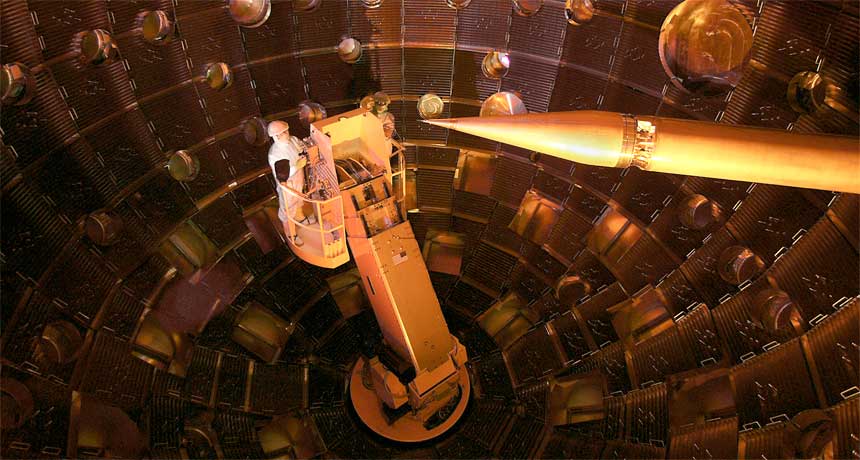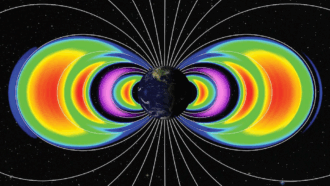Closing in on fusion energy
With 192 laser beams and a tiny amount of hydrogen, scientists take one step closer to harnessing a powerful energy source

This photo shows workers performing maintenance on the target chamber at the National Ignition Facility. The pencil-shaped feature on the right will hold a capsule containing hydrogen while laser beams fire at it from all directions.
LAWRENCE LIVERMORE NATIONAL LABORATORY
Share this:
- Share via email (Opens in new window) Email
- Click to share on Facebook (Opens in new window) Facebook
- Click to share on X (Opens in new window) X
- Click to share on Pinterest (Opens in new window) Pinterest
- Click to share on Reddit (Opens in new window) Reddit
- Share to Google Classroom (Opens in new window) Google Classroom
- Click to print (Opens in new window) Print
Last September, scientists fired 192 laser beams all at once at a pebble-sized plastic capsule. Inside the capsule: a layer of frozen hydrogen. The brief blast lasted only 160 trillionths of a second. Still, it was powerful enough to set off a flurry of reactions in which the cores, or nuclei, of hydrogen atoms fused together. This nuclear fusion released enough energy to also cause other nearby nuclei to fuse. Those fused nuclei released enough energy to keep the reaction going — if only briefly.
Nuclear fusion is the reaction that powers the sun and other stars. Scientists have dreamed of a day when controlled fusion reactions might unleash huge amounts of energy here on Earth, too. But that hasn’t happened yet. Researchers still need to figure out how to get a fusion reaction to release more energy than it needs to get started. And once those reactions start, they need to keep going — on their own — until engineers choose to turn them off.
For that to happen, scientists must create a chain of ongoing reactions in the hydrogen. That step is called ignition. Although the new experiment didn’t achieve ignition, it did provoke a very excited reaction among scientists. They hailed it as a modest milestone on the road to harnessing nuclear fusion. Indeed, the new test produced almost 10 times as much energy as previous fusion trials that had been triggered by lasers.
The researchers conducted the experiment at the National Ignition Facility (NIF) in Livermore, Calif. Their new results appear in the Feb. 12 Nature.
“It’s a very important milestone,” Steven Rose told Science News. “However,” he adds, “there are many other milestones to pass.” A physicist at Imperial College London, Rose did not work on the study.
The goal
Nuclear fusion occurs only at extremely high temperatures and pressures. During this process, the cores of two atoms join together to form a new and bigger element, at least briefly. Usually, these atoms must have very light nuclei. Hydrogen is the lightest of all: Its nucleus normally contains only one particle: a proton. The experiment in Livermore, however, used heavier isotopes of hydrogen. That means the nucleus of each atom contained an extra particle (neutron) or two. When two heavy-hydrogen atoms fuse, they form a single helium nucleus. The process also sheds a neutron — and lots of energy.
In stars, the reaction between hydrogen nuclei releases enough energy to trigger other nuclei to fuse. That, in turn, sheds even more energy. And this triggers still more fusion reactions. The process continues until the stars begin to run short on fuel.
Scientists want to create that same reaction in the laboratory, but on a much smaller scale. Once started, the chain reaction should continue to release heat for generating electricity — until engineers turn a fusion reactor off. What makes the process so attractive is its hydrogen fuel is so plentiful. If scientists succeeded in igniting self-sustaining — and controlled — nuclear fusion, Earth should possess an almost limitless source of energy.
The hitch: Achieving ignition is extremely difficult. In 2009, NIF scientists predicted that if lasers could squash the frozen hydrogen to one thirty-fifth of its original size, the fuel’s temperature would soar to 50 million degrees Celsius (90 million degrees Fahrenheit). Under those conditions, fusion should begin — and, eventually, produce more energy than the lasers had delivered to get the whole process started.
“A lot of people thought this would be a walk in the park,” Robert McCrory recalls. A physicist at the University of Rochester in New York, he often works on NIF projects.
NIF hasn’t reached ignition, however. The experts don’t know why, but hydrogen doesn’t easily compress. Instead, the capsules of this fuel often warp into bulbous shapes. They then tear apart before much fusion takes place.
The challenge
“Mother Nature doesn’t like putting a lot of energy into small volumes,” notes physicist Omar Hurricane, “so she fights you on it.” He worked on the new study at the Lawrence Livermore National Laboratory, where NIF is based.
In the new laser-fusion tests, the plastic shell with hydrogen inside was sealed inside a small gold cylinder, called a hohlraum. Lasers blasted it with 1.8 million joules of energy. Only about half of one percent — some 11,000 joules — made it to the hydrogen. The remaining energy was lost. Still, enough energy reached the fuel to start fusing hydrogen.
The experiment produced about 5,100 trillion fusion reactions. Together, they released 14,000 joules of energy. That is more energy than reached the hydrogen pellet. The rub: It’s also far, far less energy than what the lasers originally shot at the target.
For comparison, imagine a candy store in another city offered $1.27 worth of candy for $1. But to get to the candy store, you first had to buy a $162.64 bus ticket. So you could end up with 27 cents’ worth of free candy — but only after spending $163.64 in total. That is a lot more than $1. Clearly, that would not make sense to do. Similarly, triggering fusion power with lasers is not yet affordable. But scientists are convinced that with much work, it will be.
For now, they’re looking for a way to spend less energy on the setup. And the new experiment suggests they’re on the right track.
That’s why, Hurricane explains, after hearing about this latest experiment, “A lot of people are jazzed.”
Power Words
atom The basic unit of a chemical element.
bulbous Having a bulb-like shape.
hohlraum A German term meaning empty cavity. In the fusion experiments, it was the name given to a small gold cylinder used as the target.
hydrogen The lightest element in the universe. As a gas, it is colorless, odorless and highly flammable. It’s an integral part of many fuels, fats and chemicals that make up living tissues.
ignition (in chemistry) The act of igniting a fuel in combustion, such as natural gas or gasoline. (in physics) The act of launching a self-sustaining nuclear fusion reaction, one that keeps releasing energy until engineers choose to shut the process down.
isotopes Different forms of an element that vary somewhat in weight (and potentially in lifetime) based on having a different number of neutrons in their nucleus.
joule The amount of energy needed to produce one watt for one second. Joule is a standard unit of energy.
laser A device that generates an intense beam of coherent light of a single color. Lasers are used in drilling and cutting, alignment and guidance, and in surgery.
milestone An important step on the road to stated goal or achievement. The term gets its name from the stone markers that communities used to erect along the side of the road to inform travelers how far they still had to go (in miles) before reaching a town.
neutron A subatomic particle carrying no electric charge that is one of the basic pieces of matter. Neutrons belong to the family of particles known as hadrons.
nuclear fusion The process of forcing together the nuclei of atoms.
nucleus (plural: nuclei) In physics, the central core of an atom, containing most of its mass. In biology, the core of a cell, containing all or most of its DNA.
physics The scientific study of the nature and properties of matter and energy. Classical physics is an explanation of the nature and properties of matter and energy that relies on descriptions such as Newton’s laws of motion. It’s an alternative to quantum physics in explaining the motions and behavior of matter. A scientist who works in that field is known as a physicist.
proton A subatomic particle that is one of the basic pieces of matter. Protons belong to the family of particles known as hadrons.
warp A change in the shape, usually due to some twisting or curving in a normally flat surface or plane. A piece of wet lumber may warp as it dries unevenly, causing it to bow or show a slight twist.







